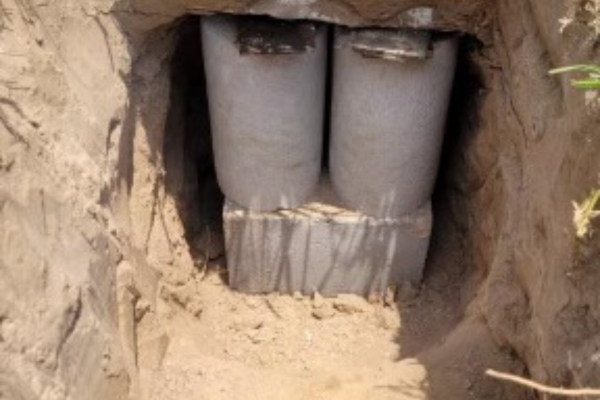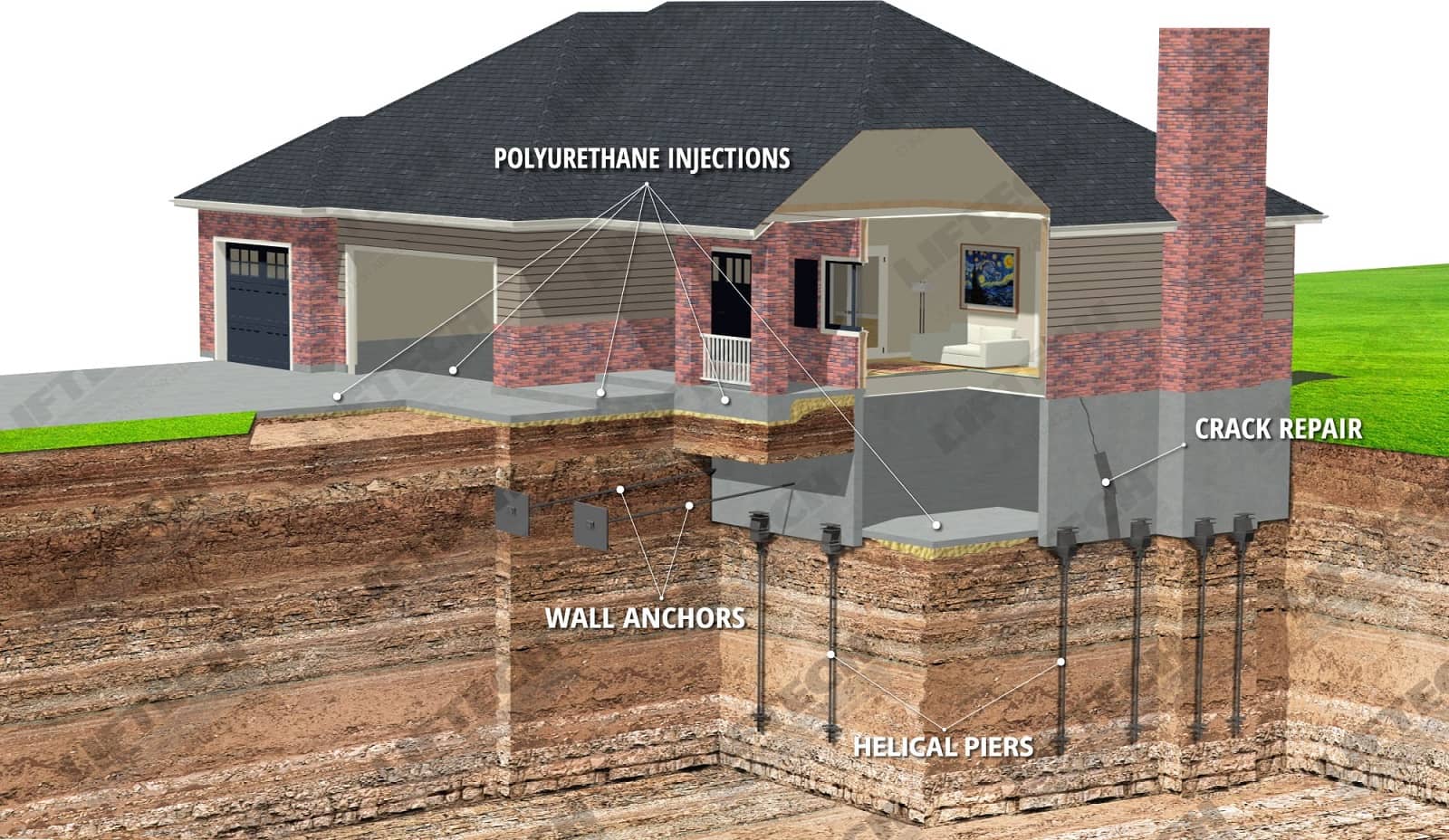Discovering Different Methods of Foundation Repair for Numerous Dirt Kinds
Structure repair is an essential aspect of keeping structural honesty, specifically when considering the diverse obstacles presented by different soil kinds. The intricacy of soil behavior under differing conditions requires a customized method to fix, making certain ideal options such as helical piers for unsteady dirts or chemical cements for natural layers. Nevertheless, the inquiry stays: how do we figure out one of the most effective technique for each special situation? Understanding the interplay in between soil features and fixing techniques is important, yet there is more to uncover in the pursuit for lasting services. What elements genuinely dictate the option of approach?
Understanding Soil Types
Dirt kinds play a crucial duty in the stability and durability of structure structures, making it crucial for property owners and building and construction professionals to recognize their attributes and actions. The communication between soil and structure can determine the architectural honesty of a building. There are several soil kinds, each with distinctive physical residential properties that impact just how structures are developed and kept.
Granular dirts, such as sand and crushed rock, provide great drain and are commonly taken into consideration steady. In comparison, cohesive soils like clays and silts display various habits.
Rocky dirts, known for their stamina and security, offer outstanding support for structures but might need specialized equipment for excavation. On the other hand, fertile dirts, which are a balanced mixture of silt, sand, and clay, commonly give desirable problems for structure assistance due to their modest drainage buildings.

Recognizing these soil types is important for picking appropriate foundation repair approaches, making certain the sturdiness and safety and security of frameworks over time.
Obstacles With Large Clay
Among the numerous soil kinds, extensive clay provides one-of-a-kind difficulties for structure security as a result of its propensity to undergo significant quantity adjustments with dampness variation. This sort of dirt swells when damp and contracts when dry, which can apply significant stress on structures. These variations can result in foundation fracturing, heaving, and settlement issues, positioning significant risks to the architectural honesty of structures.
The obstacles with large clay are worsened by its plasticity index, which determines the dirt's capacity to change shape and quantity. A high plasticity index suggests higher capacity for movement, boosting the probability of damage to foundations. This is particularly troublesome in regions experiencing extreme or regular weather changes, where cycles of damp and completely dry problems are common.
Furthermore, the deepness of large clay layers can differ, complicating the evaluation and preparation of suitable foundation repair methods. These intricacies need a detailed geotechnical assessment to guarantee reliable foundation repair approaches are carried out, stressing the importance of resolving expansive clay obstacles with know-how and treatment.
Solutions for Sandy Soils
Sandy dirts, defined by their huge fragment dimension and low cohesion, present distinctive difficulties for structure security due to their tendency for changing and erosion. By securing the structure to much deeper, a lot more stable soil layers, these systems can provide the necessary support to combat the shifting nature of sandy dirts.
An additional advised strategy is the application of dirt stabilization techniques. Chemical grouting, for example, includes infusing a supporting agent into the dirt, which enhances cohesion and lowers permeability. This procedure assists to strengthen the sandy substratum, thus reducing the risk of disintegration and motion.
Furthermore, installing proper drainage systems is essential in sandy soil problems. Making sure sufficient drainage can stop water build-up around the structure, which typically exacerbates disintegration and soil displacement. Strategies such as French drains pipes or surface grading can be used to route water away from the structure perimeter.
Dealing With Clearing Up in Loamy Soils
Loamy dirts, understood for their balanced mix of clay, sand, and silt, provide an abundant base for several frameworks yet can often result in foundation settling because of their unique structure. This well balanced appearance provides excellent drain and nutrient retention, making it suitable for agriculture and landscaping. However, this very same characteristic can end up being learn this here now bothersome for structures, as changes in moisture web content can trigger the dirt to broaden or agreement, leading to working out.
Attending to settling in fertile dirts needs a complex technique. Originally, precise soil screening is vital to establish the details make-up and dampness content of the loam. Once information is gathered, applying proper drainage services is necessary to keep regular dampness levels, thereby reducing the risk of soil tightening or development. French drains or surface area grading work techniques to redirect water far from the structure.

Innovative Repair Work Strategies
In the world of foundation fixing, cutting-edge techniques are constantly being created to deal with the complex tests positioned by various soil problems. As soil kinds differ considerably in their architectural residential or commercial properties, standard methods may not constantly are sufficient. The arrival of brand-new technologies in foundation repair supplies much more tailored services, making sure security and longevity.
One noteworthy innovation is using helical piers, which are particularly reliable in large or unpredictable soils (foundation repair okc ok). These piers are screwed into the ground until they reach a secure layer of dirt, offering check my site strong support for the structure above. This approach minimizes disruption and is adaptable to various dirt kinds, making it a versatile service
One more cutting-edge technique is the application of polyurethane foam injection. This approach entails infusing high-density polyurethane foam under the structure to fill up gaps and visit this web-site maintain the framework. It is a much less invasive alternative to typical support, providing quick installment with marginal disruption to the surrounding area.
Furthermore, soil stablizing approaches, such as the use of chemical grouts, have gotten traction. These substances improve dirt strength and lower leaks in the structure, protecting against future changing. Collectively, these ingenious repair work techniques give reliable solutions for the varied challenges posed by differing dirt conditions.
Final Thought

Structure repair is an important facet of preserving structural stability, particularly when taking into consideration the diverse difficulties positioned by different dirt types (foundation repair Oklahoma). The intricacy of dirt actions under differing problems requires a customized method to fix, making sure optimum remedies such as helical piers for unstable soils or chemical cements for natural layers. By anchoring the foundation to deeper, more secure dirt layers, these systems can provide the necessary support to counteract the moving nature of sandy soils
Structure repair work calls for careful consideration of soil kinds to make certain stability and longevity. Chemical grouts boost soil strength and lower leaks in the structure in cohesive dirts.